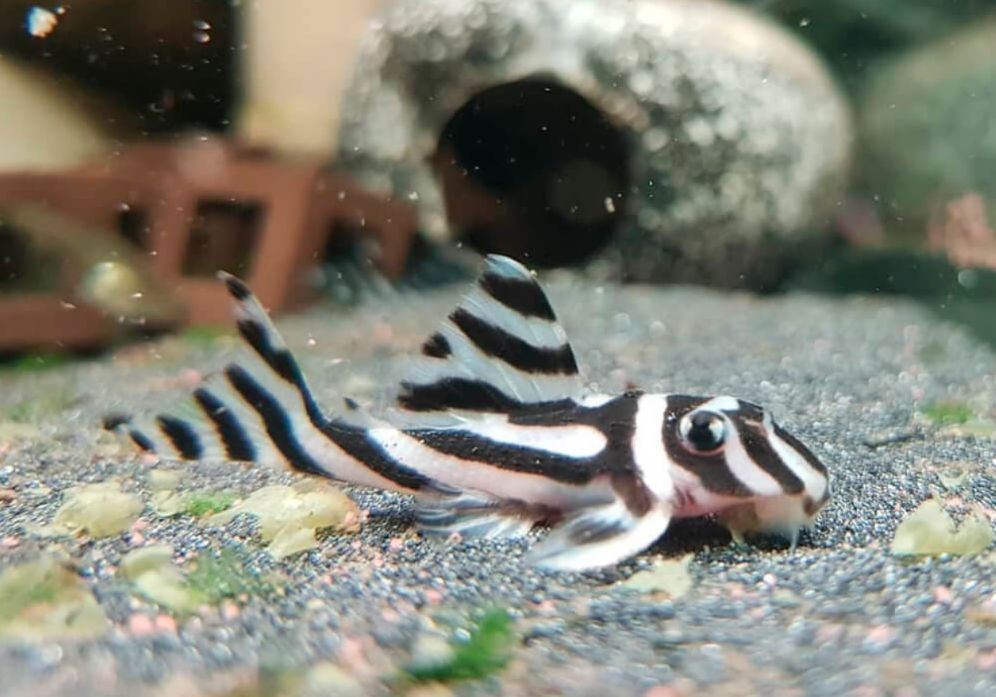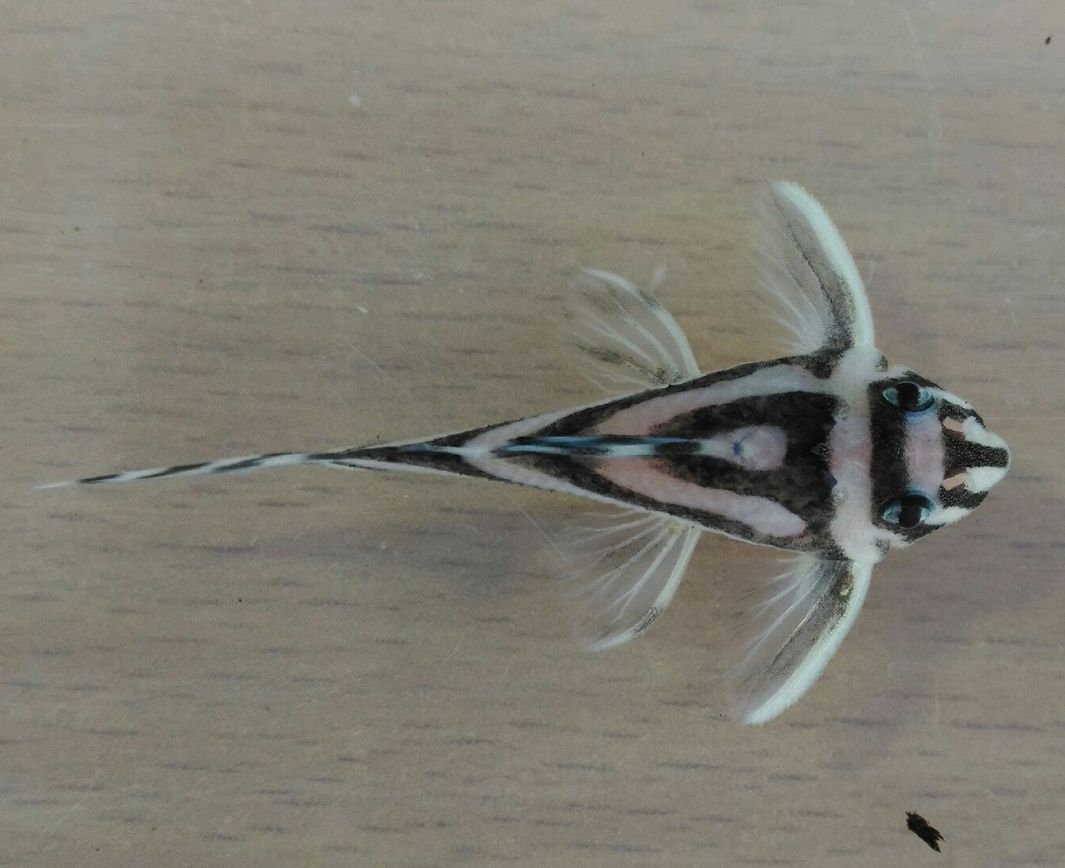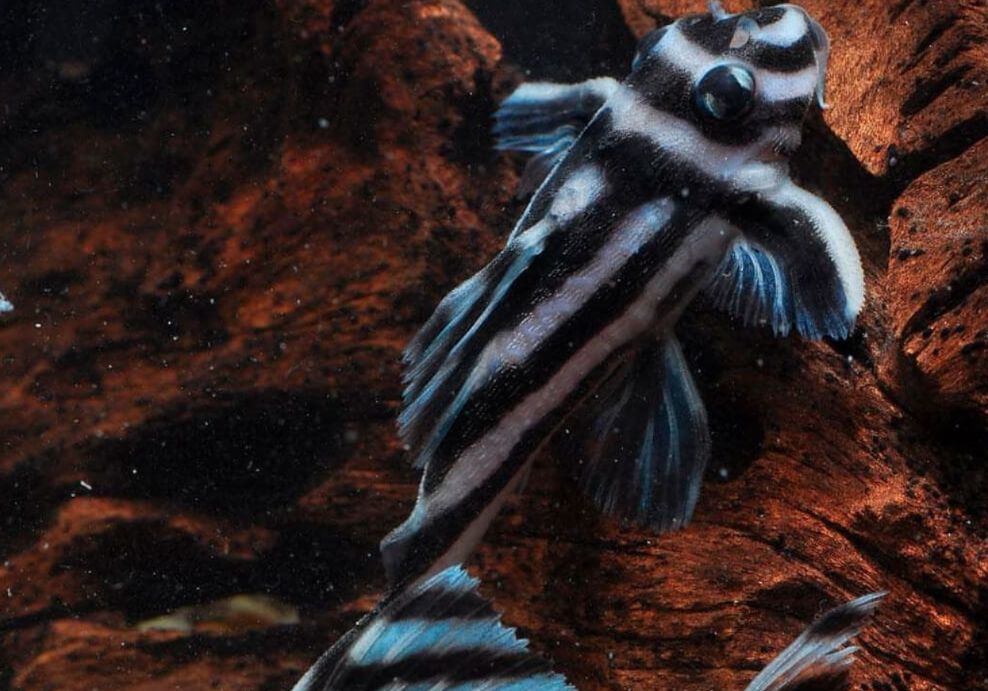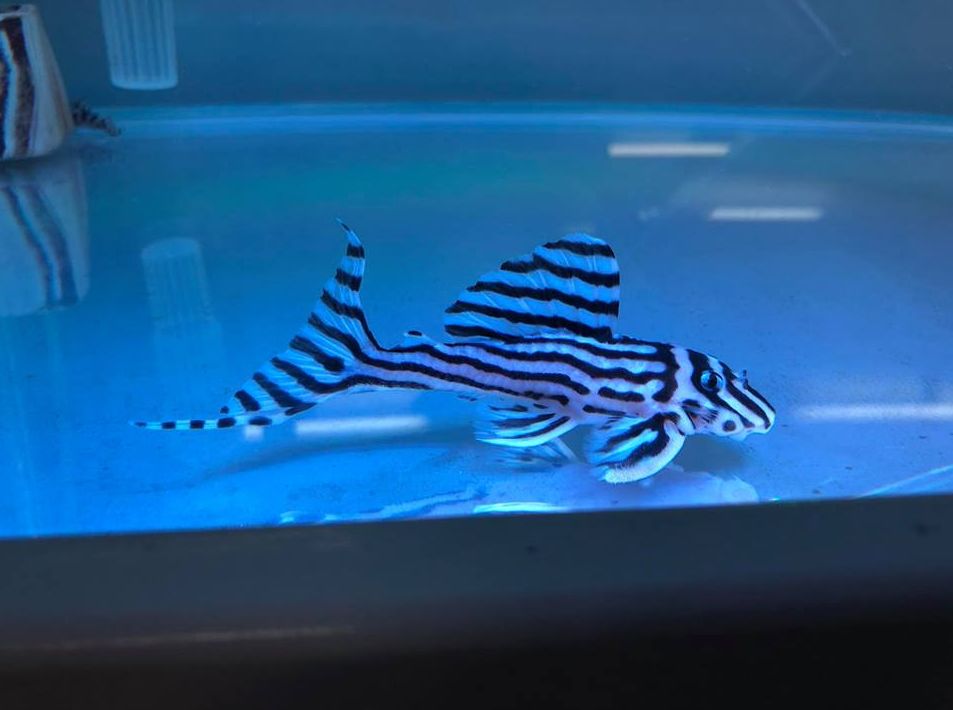The zebra pleco (Hypancistrus zebra “L046”) is one of the most beautiful and unusual catfish that aquarists can find on sale. However, you can find various and quite controversial information about the fish keeping, feeding and breeding. Even the history of how the fish was discovered is full of questions, despite the fact that it happened somewhere between 1970-80. Earlier, to denote the fish they used L-number – L046, but in 1991 the species got its scientific description.

Contents
Habitat in the wild
The L046 is specifically associated with the species Hypancistrus zebra, commonly known as the “Zebra Pleco”. These fish are highly sought after in the aquarium hobby due to their striking appearance and unique patterns.
Plecos, or plecostomus, belong to the family Loricariidae, which is a large family of freshwater catfishes native to South America. They are known for their ability to help keep aquariums clean by grazing on algae and detritus. Different species of plecos have different requirements in terms of tank size, water conditions, and diet, so it’s essential to research and provide appropriate care for the specific species you’re interested in, including the L046 Zebra Pleco.
Generic name Hypancistrus originates from two Greek words “hypo” and “ἄγκιστρον”, which mean ‘lower’ and ‘hook’. Obviously, the fish obtained its generic name “zebra” due to the similarity of its coloring to black and white one of African zebra.
Zebra pleco is endemic of Brazil river Xingu, Amazon river tributary. This is a quite wide river with average temperature about 32°C. The river bed has lots of stones and pebbles of various size with small grained sand between them.
It is considered that catfish habitat is a deepwater area in the center of the river bed, because this is where Hypancistrus is caught. At that there are a lot of different cracks, caves and burrows on the river bottom, they appear due to specific rocks and water flows there. The zebra pleco hides inside these caves and cracks, that’s why some shelters like this should be present in a tank.
There are very few snags and almost no plants on the bottom and the water flow is fast, which makes the water oxygen-rich. Still there are debates among aquarists whether this species require snags in a tank or not. Since many species need wood to chew and to improve their digestion processes, it is recommend to put a small snag in a tank.
Nowadays zebra pleco is critically endangered. Due to power plant construction the habitat of the fish is pounding and future repercussions for the ecosystem are difficult to foresee. Since pounding effects river flow rate, level of water saturation with oxygen will decrease, as a result survival of the fish species will be really endangered.
The zebra pleco has a relatively small natural range, which makes it vulnerable to habitat disruption. Overcollection for the aquarium trade can also impact wild populations. Since 2004 fishing and exporting of zebra pleco (and other numbered catfishes) from Brazil was completely prohibited by the government and the fish was added to the list of endangered species.
At attempt of smuggling the breaker is penalized and it can be even imprisoned. All these measures contribute to the high price of this species.
Due to its status in the aquarium trade and its limited habitat, there have been efforts by both hobbyists and conservation organizations to breed the zebra pleco in captivity. Captive breeding can help reduce the impact on wild populations and ensure a sustainable supply for the aquarium trade.


Description
In captivity these fish typically reaches a size of about 3 to 4 inches (approximately 7.6 to 10.2 centimeters) in length when fully grown. This makes them a relatively small species in the pleco family. Keep in mind that individual sizes can vary based on factors such as genetics, diet, and the specific conditions in which they are kept.
Lifespan
The lifespan of a Hypancistrus zebra in a well-maintained aquarium can vary, but under optimal conditions, they can live for approximately 10 to 15 years or even longer. Proper care, including providing a suitable environment, balanced diet, and good water quality, is essential to ensure the longevity and health of your zebra plecos. As with many fish species, individual genetics and the quality of care they receive play significant roles in determining how long they live.
Coloring
Hypancistrus zebra distinctive feature is its unusual coloring, that consists of black and white stripes due to which the fish got its name. The coloring is snow-white with bluish tint on its tale. Tar dark diagonal stripes go along its body and end on its caudal fin.
The stripes become lateral on the head and vertical on the dorsal and pectoral fins. You may encounter species with undulated and dashed black stripes on their body. The eyes are bluish. The head is quite elongated with high set eyes. If you look on the fish from above you’ll notice that its eyes are connected with wide white stripe and four lateral stripes of the same color go to the mouth.
The maxilla has seven-eight long curved teeth from each side, that bifurcate closer to the edge. There are only eight deeply bifurcated teeth on the mandible; four from each side. The fish also has 2 pairs of small barbels.
The zebra pleco has an elongated hooked pin on its premaxilla.
The anal fin consists of 1 coarse and 4 soft rays. All fins of the adult species – abdominal, dorsal, anal and tail one are also decorated with black and white stripes that go in turns.
| Characteristic | Description |
|---|---|
| Scientific Name | Hypancistrus zebra |
| Common Names | Zebra Pleco, L046, zebra catfish |
| Origin | Xingu River, a tributary of the Amazon River, Brazil |
| Size | Approximately 3-4 inches (7.6-10.2 cm) |
| Lifespan | Typically 10-15 years or more |
| Habitat | Rocky areas with moderate to fast-flowing water |
| Water Parameters | Temperature: 78-82°F (25-28°C), pH: 6.5-7.5 |
| Diet | Omnivorous, feeds on high-quality sinking pellets, fresh vegetables, and occasional protein-rich foods |
| Behavior | Nocturnal, reclusive, often found hiding in caves and crevices |
| Conservation Status | Considered to be a species of concern due to habitat loss and popularity in the aquarium trade |
| Aquarium Setup | Provide hiding spots with caves, smooth substrate, and good water quality. Keep tankmates that are peaceful and not aggressive. |
| Breeding | Breeding in captivity has been successful, helping to reduce pressure on wild populations |

Difficulties in keeping
Zebra pleco is quite demanding in terms of tank conditions and that’s why it’s not recommended for beginner aquarists to keep.
Care and keeping in a tank
Water parameters
The zebra pleco requires warm oxygen-rich and clean water. Maintaining appropriate water parameters is crucial for the health and well-being of the Hypancistrus zebra in an aquarium. It is important that tank water parameters and quality stay stable, otherwise any abrupt changes may cause death of your pets. If the zebra pleco changes its behavior in some way, for example, loss of appetite or extreme flaccidity – these manifestations indicate that something is wrong with tank conditions. In this case it is recommended to renew 1/3 of the tank water with fresh one, rise its temperature up to 30 °C and perform tank water filtration using charcoal filter.
Perfect tank conditions will be the following:
- Temperature: Keep the water temperature in the range of approximately 78 to 82°F (25 to 28°C). It’s essential to provide a stable temperature within this range to mimic their native environment.
- pH: Aim for a slightly acidic to neutral pH level in the range of 6.5 to 7.5. Zebra plecos prefer water that is not too alkaline.
- Hardness: Maintain moderate hardness levels. A general guideline is a hardness of 2 to 15 dGH (German degrees of hardness) or approximately 36 to 268 ppm.
- Ammonia, Nitrite, and Nitrate: Keep ammonia and nitrite levels at zero, as these compounds are toxic to fish. Nitrate levels should be kept relatively low, ideally below 20 ppm. Regular water changes and effective filtration are essential for managing these parameters.
- Oxygenation and Water Movement: Provide sufficient oxygenation and water movement in the aquarium, especially if you have a well-decorated tank with hiding spots. Adequate oxygen levels are crucial for the health of the zebra plecos.
- Filtration: Use a good-quality aquarium filter capable of handling the waste produced by the fish. Efficient filtration helps maintain water quality and prevents the buildup of harmful compounds.
It’s crucial to monitor water parameters regularly using appropriate test kits to ensure they remain within the recommended ranges. Keeping the water clean and stable is essential for the overall health and longevity of the zebra plecos in your aquarium.
Tank size
In a tank about 25 inches long you can easily keep about 4-5 species of this catfish. If there are more fishes you’d like to keep, the tank volume should be larger. Another thing you should bear in mind, is that the larger is the tank, the easier it is to maintain tank water parameters and control how they change.
The appropriate tank size for l046 pleco depends on several factors, including the number of plecos you plan to keep, the presence of other tank mates, and the overall setup of the aquarium. Here are some guidelines for selecting an appropriate tank size:
- Single Zebra Pleco: If you’re planning to keep a single zebra pleco, a tank with a capacity of at least 20 to 30 gallons (75 to 113 liters) should be sufficient. While these fish are small, providing them with enough space helps ensure their well-being and allows for a more natural environment.
- Multiple Zebra Plecos: If you plan to keep a small group of l046 plecos, you’ll need a larger tank to accommodate them. A tank with a capacity of 30 to 50 gallons (113 to 189 liters) or more is recommended for a small group of zebra plecos. Providing enough hiding spots, caves, and territories for each pleco is essential in a group setup.
- Consider Tankmates: If you plan to have other fish in the same aquarium with the zebra plecos, you need to consider the needs and potential interactions of the tank mates. Make sure the tank is large enough to accommodate the plecos along with any other fish without causing overcrowding or territorial conflicts.
- Aquarium Dimensions: The tank’s dimensions are important, especially if you plan to include decor such as caves and rocks. Zebra plecos appreciate hiding spots, so having enough space for these features without making the tank feel cramped is important.
- Water Quality: Maintaining stable water quality is essential for zebra plecos. A larger tank provides more water volume, which can help dilute toxins and fluctuations in water parameters.
Remember that zebra plecos are somewhat reclusive and appreciate hiding spots, so providing caves and structures in the tank is important. Regardless of the tank size you choose, focus on creating a well-maintained and stable environment with appropriate filtration, regular water changes, and suitable decorations for the plecos to thrive.
Tank decor
You can put some tank plants, but remember that the tank water temperature is quite high and not all plants can do with it. Snags and various roots are both good shelters for the fish and tank decorations, so aquarists widely use them in such tanks. Slate stones are also used to build shelters for the fish.
Zebra pleco is a nocturnal fish and it becomes active when nightfall comes. Almost all of their time spends near the tank bottom. To make sure that the zebra pleco can hide at any moment, put lots of shelters on the tank bottom. They should be of proper size to let your pets feel comfortable there. Pottery vessels, snags, stones and caves can be used for this purpose.
The number of shelters in the tank has to be larger, that that of the fish dwelling there. Shelters should be both with one exit and pass-through ones.

Tank mates
Zebra pleco has peaceful temper and as a rule they don’t show any aggression towards their tank mates. But at that they aren’t very suitable for dwelling in a community tank.
The fish needs warm water, strong water flow and high saturation of water with oxygen. Besides the fish is very timid and it’d rather refuse from food than compete for it with its more active tank mates. You can keep pleco with discus fish. They have similar biotopes, requirements for water temperature. The only thing they have different is high water flow rate that zebra pleco needs.
Perfect idea in this case is to keep a group of zebra, that consists of one male and several females. Catfishes are not aggressive and can be kept in community tanks with other peaceful species.
Diet
Zebra pleco isn’t demanding in terms of food. Unlike common catfishes, the fish prefers protein food. Though you can offer it both vegetable and protein food.
Here’s a recommended diet for zebra plecos:
- High-Quality Sinking Pellets: A staple in their diet should be high-quality sinking pellets specifically designed for bottom-dwelling fish. These pellets usually contain a balanced mix of plant-based and animal-based ingredients. Look for pellets that are rich in fiber and protein.
- Fresh Vegetables: Zebra plecos appreciate fresh vegetables such as zucchini (courgette), cucumber, and spinach. These veggies should be blanched (quickly boiled) or soaked to soften them before offering to the fish. Remove any uneaten vegetables from the tank to prevent water quality issues.
- Protein-Rich Foods: Offer protein-rich foods occasionally, but not as a primary diet component. This can include live or frozen foods like brine shrimp, bloodworms, daphnia, and high-quality fish pellets with a higher protein content.
- Supplements: Consider using high-quality fish supplements to provide essential vitamins and minerals that may not be present in their primary diet.
Remember to feed them in small portions to prevent overfeeding, which can lead to water quality problems. Observe their eating habits and adjust the frequency and amount of food based on their activity level and overall condition. Providing a varied and nutritionally balanced diet is key to keeping your zebra plecos healthy and thriving in your aquarium.
Gender differences: male vs female
Distinguishing between male and female Zebra Plecos (Hypancistrus zebra) can be somewhat challenging, especially when they are not in breeding condition. However, there are a few subtle differences that can sometimes help differentiate between the sexes:
- Size and Body Shape: In some cases, mature males might be slightly larger than females, and they can have a more robust and muscular appearance. This difference in body shape may be more noticeable in breeding individuals.
- Adipose Fin: The adipose fin is a small, fleshy fin located on the back, just ahead of the tail fin. In some male zebra plecos, the adipose fin may be more developed or have a slightly different shape compared to females. However, this difference is often subtle.
- Papilla: In breeding females, a small genital papilla may be visible near the vent (anus). This papilla can be difficult to observe, and it is not always a reliable indicator.
- Behavior during Breeding: One of the most reliable ways to differentiate between male and female zebra plecos is during breeding behavior. Males may become more territorial and exhibit courting behavior, while females may show interest in nesting sites and show signs of preparing for egg laying.
It’s important to note that these differences are not always easy to observe, and sexing zebra plecos with certainty without breeding behavior or detailed examination can be challenging. If you’re interested in breeding zebra plecos or want to confirm the sex for any other reason, it’s best to consult with experienced aquarists or breeders who have experience with this specific species.
Breeding
Zebra pleco becomes reproductive at the age of 2-4 years old. Except tank water temperature and flow, availability of proper shelters is a crucial factor that influences the breeding process. The tube has to correspond to the breeders size.
Tank water temperature can’t be lower than 25°C. Aeration should be increased. As for the breeders, they should be kept in a small group of 5-6 species.
Several zebra pleco females may spawn simultaneously with the same male – this depends on how experienced and mature the male is. Number of eggs is directly proportional to the age and size of the female fish. Young female fish as a rule lays about 5-6 eggs, but the adult one can lay up to 25 eggs.
Time interval between the spawning varies and it depends on the diet and tank water parameters. Some couples breed once or twice a year with large pauses between the spawning, others are capable of breeding more often.
The eggs are quite large. How the eggs develop depends on the water temperature – the higher it is, the faster the embryon grows. The temperature also influences the further rate of the juveniles growth.
In about two weeks the zebra pleco juveniles grow to be 1.5 mm long and they can feed themselves. At this moment you can offer them live brine shrimp or milled dry food as a diet to start with.
You can grow zebra pleco juveniles both in a tank together with their parents and in a separate volume. However, it is preferable to put the juveniles in a separate tank, since this way it is easier to control how they feed and maintain stable water parameters.
Juveniles grow very slow and usually they are about 5 cm long at the age of 12 months.
It is crucial to provide the juveniles with sufficient feeding, which will ensure higher rate of their growth. Daily renew of the tank water with fresh one with similar parameters, is a must when growing juveniles.